|
This image was created at Little Estero Lagoon with the Canon 70-200mm f/2.8L IS II lens and the Canon 1.4X III TC (hand held at 98mm) with the EOS-1D Mark IV. ISO 400. Evaluative metering +2/3 stop: 1/320 sec. at f/16 in Manual mode. Central Sensor/AI Servo Rear Focus and recompose. Click here if you missed the Rear Focus Tutorial. Click on the image to enlarge it. |
Solving Plover Problems
You come upon a large group of Wilson’s Plovers roosting in a field of horse mussels. Isolating a single bird will be difficult and the jumble of large mussels will make for distracting backgrounds in most cases. Confident in their camouflage, the birds are exceedingly tame. What are the best strategies for long lens photography? Your first impulse with tame shorebirds it to get out your Panning Ground Pod or you Skimmer II (or to splay the legs of your tripod) and get down flat on the beach. Would you do that here? (See below for the answer….)
Before you go on please leave a comment and let us know a few things: How many birds do you see in the image above? Are they all Wilson’s Plovers? Why should I have either taken off my teleconverter or taken one big step backwards?
|
This image was created with the Canon 70-200mm f/2.8L IS II lens (hand held at 70mm) with the EOS-1D Mark IV. ISO 400. Evaluative metering +2/3 stop: 1/320 sec. at f/16 in Manual mode. Central Sensor/AI Servo Rear Focus and recompose. Click here if you missed the Rear Focus Tutorial. Click on the image to enlarge it. For this image I did remove the 1.4X TC obviously to get wider. |
From left to right we have half the SW FLA IPT group: Lynne, Clemens, Wayne, Gail, and Deirdre. The first instinct of several of the folks in the group was to get flat on the ground but I quickly pointed out that the lower you got in this situation the more distracting background elements you would introduce. The best chance to eliminate horse mussels (or at least most of them) from your backgrounds was to remain standing behind your tripod and that is what I did. Kneeling was a good second option. Notice how tame the birds are. And notice the Snowy Egret down at the edge of the Gulf. Click here and scroll down to read the SW FLA IPT Report and see the announcement of the 2013 SW FLA IPT; hope that you can join me.
|
Wilson’s Plover and horse mussel, Little Estero Lagoon, Fort Myers Beach, FL. Created with the tripod-mounted Canon 800mm f/5.6L IS lens, the Canon 1.4X III TC, and the EOS-1D Mark IV. ISO 200. Evaluative metering +2/3 stop: 1/400 sec. at f/11 in Manual mode. Central Sensor (by necessity) Rear Focus/AI Servo AF and recompose. Click here if you missed the Rear Focus Tutorial. For a greater appreciation of the image, click on the photo. |
By standing at full height behind my Gitzo GT3530LS Tripod I was able to eliminate more than a few mussels in the distant background. When I saw the opportunity to create a nice stitched pano I created two images, one of the bird and one of the mussel (with a bit of overlap). I was careful to work in Manual mode and not to re-focus after creating the first image. I assembled the two images manually in Photoshop. I chose to leave the mussel in the upper left to balance the composition. Notice that while working in fairly harsh sunlight I opted to point my shadow exactly at the subject….
|
Wilson’s Plover and horse mussel quasi-grunge HDR, Little Estero Lagoon, Fort Myers Beach, FL. Created from three images made with the tripod-mounted Canon 800mm f/5.6L IS lens and the EOS-1D Mark IV. ISO 200. Evaluative metering +2/3 stop with +/- 1 1/3 stops auto exposure bracketing (AEB) around 1/400 sec. at f/11 in Manual mode. Central Sensor (by necessity) Rear Focus/AI Servo AF and recompose. Click here if you missed the Rear Focus Tutorial. For a greater appreciation of the image, click on the photo. Then click on the enlarged version to close it. |
When I saw a decent image motif I locked down my Mongoose M3.6, waited until the bird was completely motionless, and fired off three fast images to prevent ghosting. The quasi-HDR Grunge was created in Photomatix. I usually work at settings somewhere between the Painterly and Grunge pre-sets. To purchase Photomatix and save 15% click here and be sure to enter birdsasart as the coupon code. You can download and use a trial copy of Photomatix before you buy. It is fully operational but the processed images will have a visible watermark on them. At some point this summer I hope to finish the HDR Grunge Guide that Denise Ippolito and I started work on a while back.
|
Wilson’s Plovers, horse mussel, and limpet, Little Estero Lagoon, Fort Myers Beach, FL. This image was created with the tripod-mounted Canon 800mm f/5.6L IS lens and the EOS-1D Mark IV. ISO 200. Evaluative metering +2/3 stop: 1/500 sec. at f/11 in Manual mode. Central Sensor (by necessity) Rear Focus/AI Servo AF and recompose. Click here if you missed the Rear Focus Tutorial. For a greater appreciation of the image, click on the photo. |
Above I was working on the framing with a single plover and the horse mussel in the lower left corner when a second Wilson’s walked into the frame and paused in a spot that yielded a rather pleasing juxtaposition.
Comments on Your Comments
With some free time in Tokyo I had some time to respond to your comments at the January 13, 2012 post, My Comments On: For Your Critique/Image #8 and at the January 15, 2012 post, Pushing the Shutter Speed Envelope.
Robert O’Toole Homer Bald Eagle Offer
Robert has openings on his March 28th to April 1st, 2012 Homer, Alaska Bald Eagle trips. Click here for complete details.
Support both the Bulletins and the Blog by making all your B & H purchases here.
Remember: you can earn free contest entries with your B & H purchases. Eleven great categories, 34 winning and honored images, and prize pools valued in excess of $20,000. Click here for details.
Shopper’s Guide
Below is a list of the gear used to create the images talked about in this blog post. Thanks a stack to all who have used the Shopper’s Guide links to purchase their gear as a thank you for all the free information that we bring you on the Blog and in the Bulletins. Before you purchase anything be sure to check out the advice in our Shopper’s Guide.
Canon 70-200mm f/2.8L IS II lens. Man, I am loving this lens on my shoulder (or on a tripod as above) with the 2X III teleconverter. I also use it a lot with the Canon 1.4X III TC.
Canon 800mm f/5.L IS lens. Right now this is my all time favorite super-telephoto lens.
Canon 1.4X III Teleconverter. Designed to work best with the new Series II super-telephoto lenses.
Canon EOS-1D Mark IV professional digital camera body. My two Mark IVs are my workhorse digital camera bodies.
And from the BAA On-line Store:
LensCoats. I have a LensCoat on each of my big lenses to protect them from nicks and thus increase their re-sales value. All my big lens LensCoat stuff is in Hardwood Snow pattern.
LegCoat Tripod Leg Covers. I have four tripods active and each has a Hardwood Snow LegCoat on it to help prevent further damage to my tender shoulders 🙂
Gitzo GT3530LS Tripod. This one will last you a lifetime.
Mongoose M3.6 Tripod Head. Right now this is the best tripod head around for use with lenses that weigh less than 9 pounds. For heavier lenses, check out the Wimberley V2 head.
CR-80 Replacement Foot for Canon 800. When using the 800 on a Mongoose as I do, replacing the lens foot with this accessory lets the lens sit like a dog whether pointed up or down and prevents wind-blown spinning of your lens on breezy days by centering the lens directly over the tripod.
Double Bubble Level. You will find one in my camera’s hot shoe whenever I am not using flash.
The Lens Align Mark II. I use the Lens Align Mark II pretty much religiously to micro-adjust all of my gear an average of once a month and always before a major trip. Enjoy our free comprehensive tutorial here.
Canon EOS-1D Mark IV User’s Guide. Learn to use your Mark IV the way that I use mine. Also available for the 7D and the Mark III here.
BreezeBrowser. I do not see how any digital photographer can exist without this program.

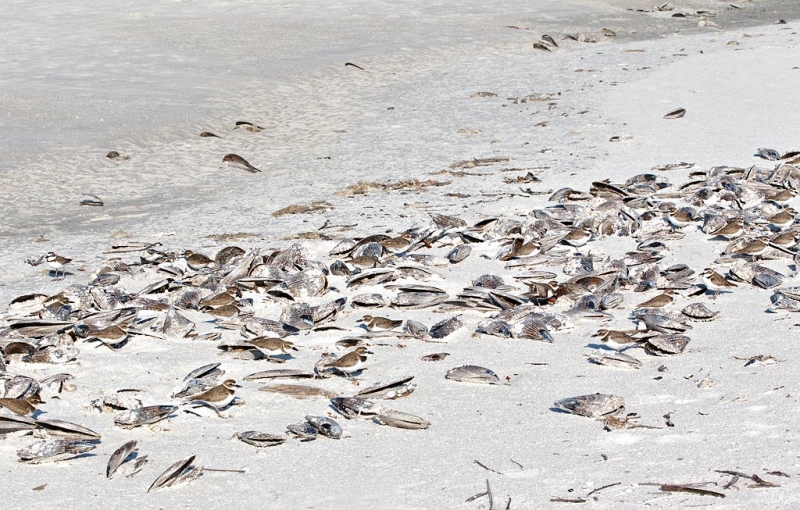
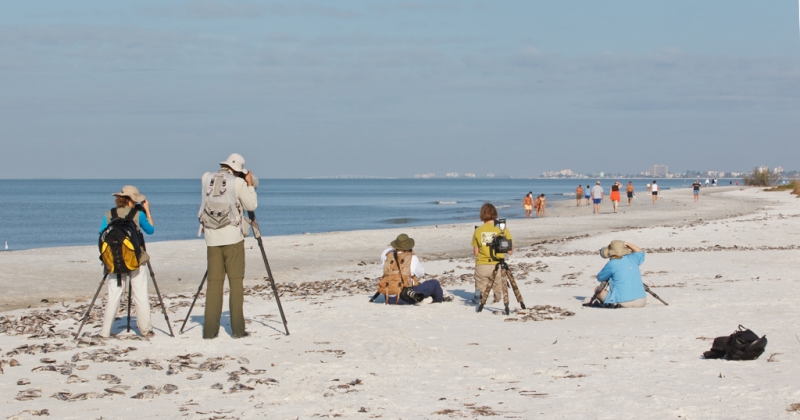
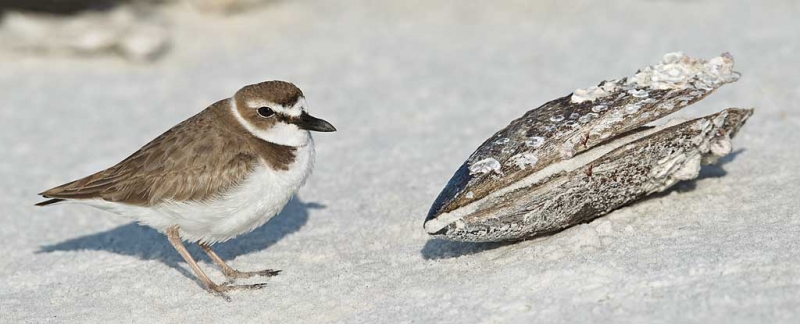
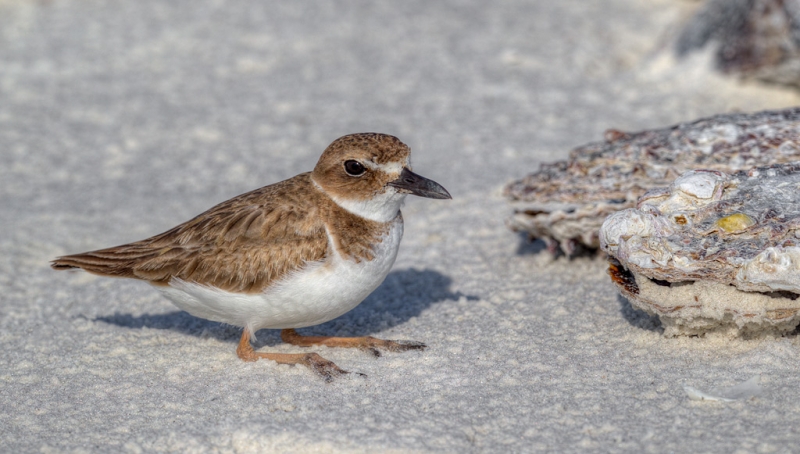
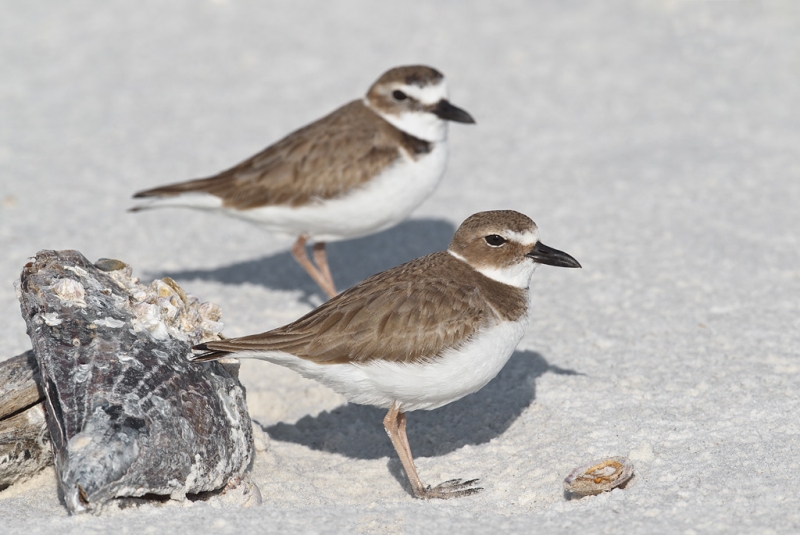
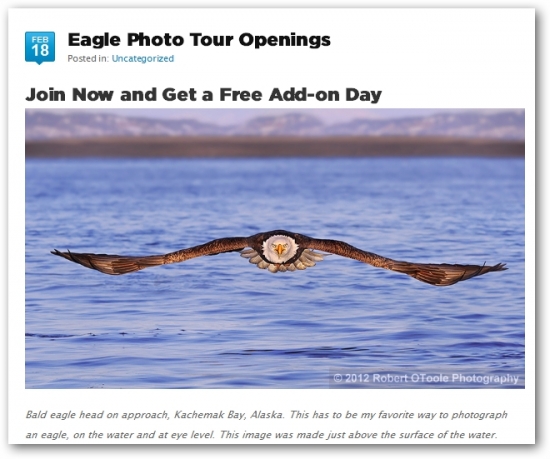













I counted 24 Wilson’s and one Semipalmated Plover on the right side in the middle doing a wingstretch. There is also what sort of looks like a bird cut in half on the far right edge at the top of the line of mussels but I don’t think that can be counted……….too hard to tell what that is. I’m also not 100% sure of the bird in the middle with its head turned away and bent over toward the back……..it seems to have the large bill of a Wilson’s so I’m calling it a Wilson’s. That was fun.
Well, I tried to copy your picture so I could mark off (in a separate layer in PS) each Plover when counted. Couldn’t do that so I counted left to right then right to left…over and over and over again. (Counting top to bottom drove me crazy.) Finally, I agree with me that there are 25. haha Anyway if you took off the 1.4X, couldn’t you try AF? At first I thought it was just debris. Great example of nature’s camoflage.
I am also curious about your location. It looks like somehwere in the neighborhood of St. Pete Beach.
I count 27 birds and think(!) they are all Wilson’s. My guess is that backing up a bit would give the picture more context and perhaps include some of the blue Gulf for some contrast in the background. Incidentally, I like the pose of the second bird best with it sitting on its legs.
I count at least 25 plovers. I believe all are Wilson’s.
I counted 26 and they all look the same to me.
Sorry, that was 2/13/12.
By my count, I see 24 plovers, but I get a different number each time I count. They all look like Wilson’s to me, with the possible exception of the bird on the left side center, that my gut wants to call a Semipalmated, but I can’t see orange legs, so smaller bill could be due to foreshortening and slightly different face pattern might be individual variation of a Wilson’s?? I’m curious to know why you might have taken a step back other than to get in more of the mussel pile. My preference would have been to get low and seek an isolated bird on the edge of the mass, which would be easier over on the edge of the lagoon with fewer impediments (see “Wilson’s Plover on defense’, posted 2/12/12).